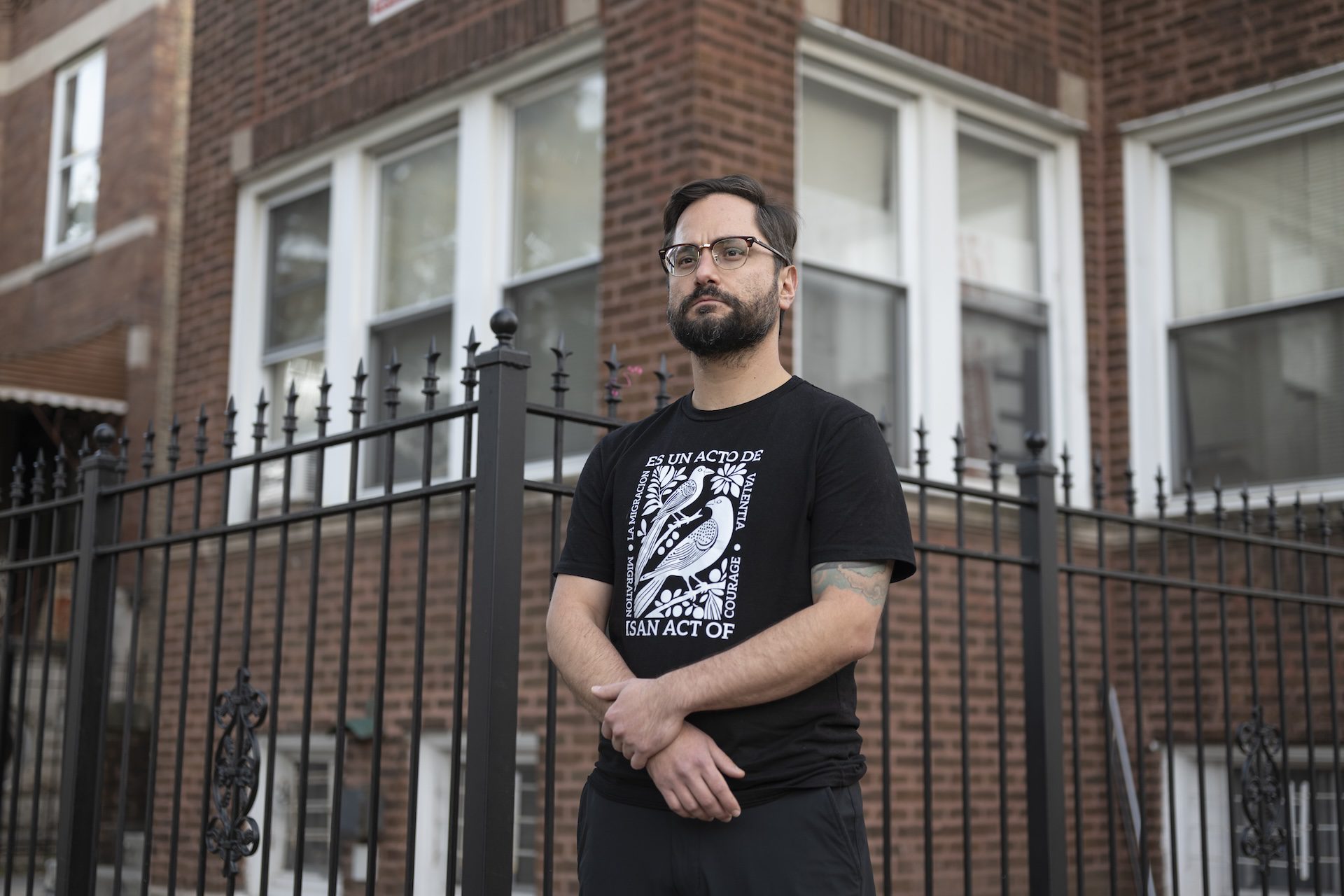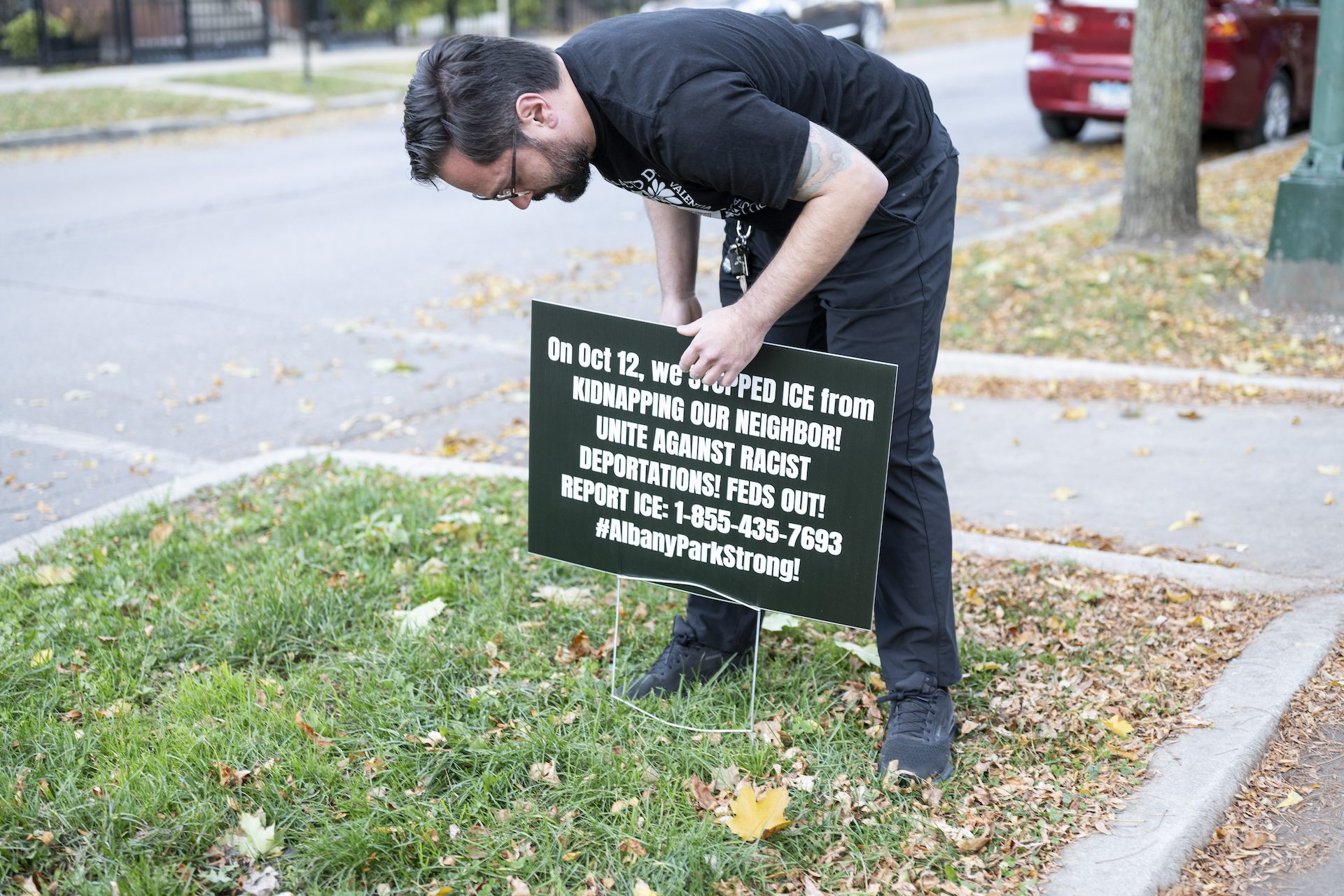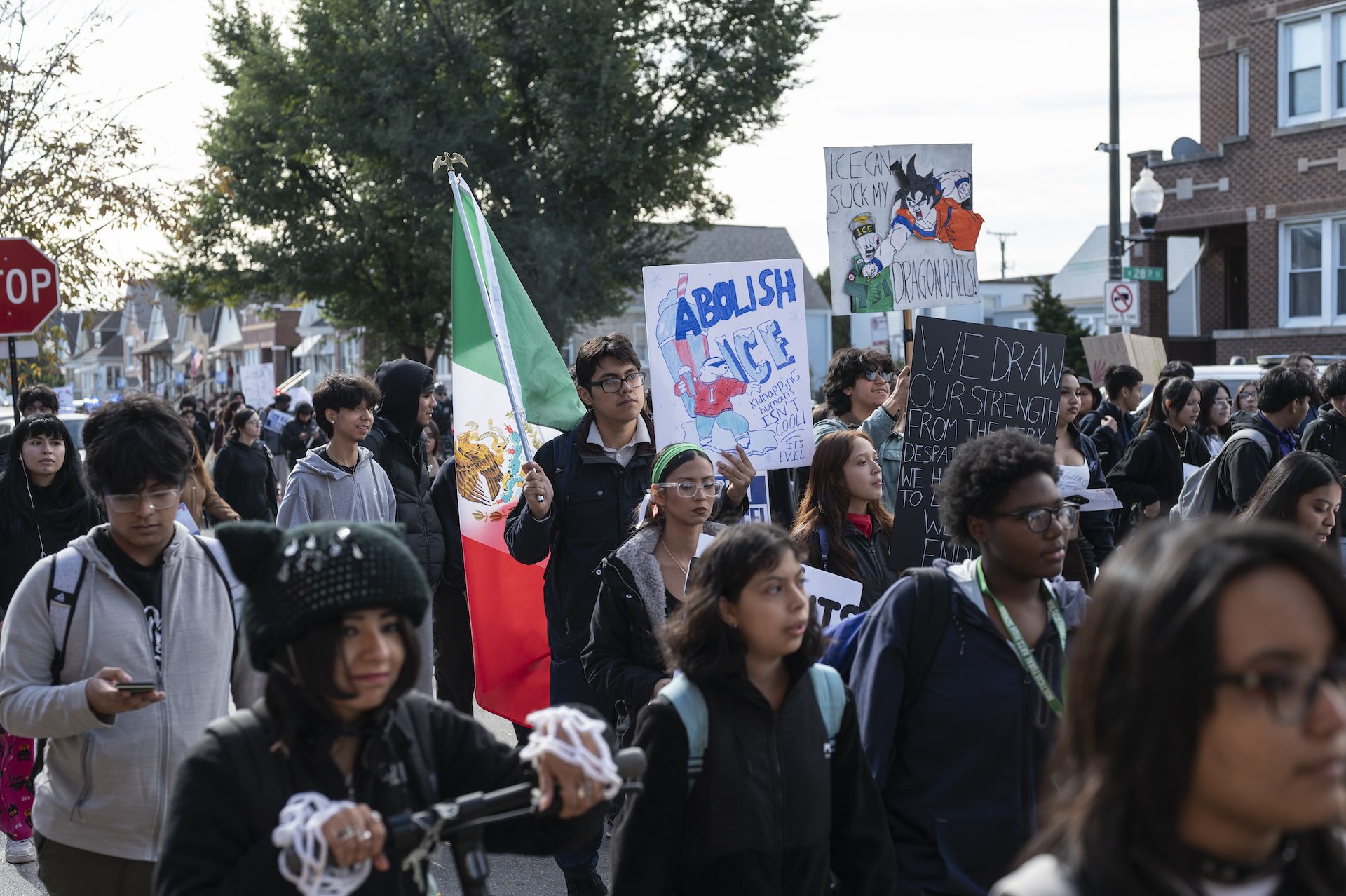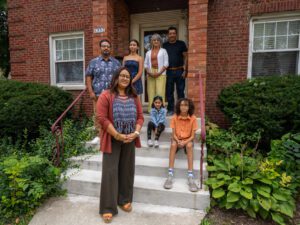 Max Herman/Borderless Magazine
Max Herman/Borderless MagazineMonths into ICE raids, Chicago teachers and community members are finding ways to help students cope with trauma inflicted on their communities.
Editor’s note [11/20/2025]: Borderless Magazine has chosen not to publish the full names of some of the sources mentioned in this story to protect their safety and privacy. For questions, please contact us at [email protected]
Kat wrote a plan for her mom: where to find her spare car keys, caregiving instructions for her dog, where to find her asthma medication and passwords to several of her personal accounts.
The list, Kat says, serves as a guide in case federal agents detain her.
News that puts power under the spotlight and communities at the center.
Sign up for our free newsletter and get updates twice a week.
Kat is a teacher born and raised on the Southwest Side, an area that’s been a target of Immigration and Customs Enforcement (ICE) raids since September.
“It felt a little bit like I was sharing how to check the boxes in my life if I’m not there,” said Kat. “Which feels like a crazy thing to have to do as just a person living your life in places that I have always been.”
The fear of being detained follows the Southwest Side resident every day that she drives to work on the North Side. She sees the same worry and vigilance over immigration raids in her students. When a helicopter flies by during recess, her students ask: “Is that ICE?”
Her students worry about whether their parents will be home when they return to school, she says.
Teachers like Kat are noticing students on high alert and withdrawing in class. Some have also seen a dip in student attendance as federal immigration agents have carried out military raids citywide. Many students skip school, while others who used to be accompanied by a parent now walk to school on their own.
School staff and community members have responded in and outside of schools to make families feel safe when students attend school, creating informal escorting systems, in-school food pantries and sanctuary teams to support affected families.
Since “Operation Midway Blitz” began in September, ICE encounters have escalated with agents teargassing neighborhoods, fatally shooting a man near schools and raiding an apartment complex with children in the middle of the night. U.S. Border Patrol Commander Gregory Bovino told WBEZ Chicago that agents were arresting people partly based on “how they look.”
In several instances, federal agents have waited outside schools, detaining parents and teenagers as other parents and students look on — elevating fears throughout school communities. In response, educators and neighbors have sought ways to alleviate the fears that have swept through immigrant communities.
“People are very high alert,” said Kat. “I think it’s affecting students and parents and teachers, and that wears on your nervous system. It’s hard to be vigilant all the time.”
Learning under a cloud of fear
Northwest Side teacher Mahli has noticed a decline in student attendance. Some students miss a day or two at a time, while others are absent for more than a week at a time.
Earlier this school year, about half her students showed up after hearing rumors of ICE targeting schools a day prior, she says.
“Attendance has definitely suffered, especially in our bilingual classrooms,” she said. “I would say that focus is affected, and there [are] more complaints about tummy aches and headaches and the energy just being down.”
According to an analysis by Chalkbeat, attendance rates dropped by 1.25 percentage points after Sept. 8, when news of immigration sweeps in Chicago became public. The decline is more than double between the first and second months of school over the last two years.
Psychologist Ricardo Camacho says children’s sense of security, trust and safety is currently threatened by aggressive immigration enforcement in their neighborhoods. This can manifest into withdrawal, difficulty concentrating and physical symptoms, he noted.
For children and students in immigrant or mixed-status families, exposure to distressing or violent social media content about immigration enforcement can reinforce feelings of fear and instability, Camacho says.
In Chicago, over one-third of school-age children have at least one immigrant parent, according to a WBEZ analysis of 2024 Census data. A recent survey by A Better Chicago, a venture philanthropy organization, found that over half of Latino youth in Chicago over the age of 15 say they “worry a lot” about a family member or friend being deported due to their immigration status.
Kat notices students are worried in her classroom, openly discussing their fears with one another.
“There are both visible and invisible effects to this, and it’s affecting every part of the community,” says Kat. “I think even more now they need that to bring joy and curiosity into the classroom.”
Navigating how and when to acknowledge their fears has been difficult, Kat and Mahli agree.
“It’s been a delicate balance between wanting to acknowledge the weight of the moment, but then also wanting it to be a joy-filled space where they feel safe in a space where they can forget about the weight of the world for a little bit,” Mahli said.
“It is my responsibility”
For teachers like Mahli, the experience has prompted her to act.
Mahli is part of her school’s sanctuary team, led by social workers, which aims to protect students and families. The team checks in on families, connects them with mutual aid and legal services, and tracks active detention cases involving parents of students. Mahli said she knows of about five cases in which ICE has detained parents from her school community.
Gabriel Paez teaches bilingual Spanish language arts, English as a Second Language and social studies to 7th and 8th-grade students in a school on the Northwest Side, most of whom are immigrants who arrived in the U.S. in the last few years.
“As an educator, we already know that we have to see our children as whole people,” said Paez. “If you are not physically safe, if you feel like you are in jeopardy or your family is unsafe, we know that higher-level thinking will not develop as it should in children.”
Inside the school, he connects his students with resources and information, including “Know Your Rights” cards and hotline numbers, which he has posted around his classroom. He is also in touch with the school counselors who work with students who are afraid of losing their parents.
Outside, he works with other neighbors to respond to ICE raids in his neighborhood. “It is my responsibility as an adult, as an American, as a naturalized U.S. citizen and as an educator to push back against ICE and make their job as hard as possible,” said Paez.

The frequency of ICE raids has spurred conversations among students about deportations.
Chicago Public Schools teacher Silvia Gonzalez said her students are having these conversations right now.
“[Students are] just having questions that they want me to answer or want to think about with me,” she said.
Gonzalez created a resource for other teachers, including a curriculum on how to have conversations with young people about these issues and “Know Your Rights” information, with the context of a classroom.

In West Town, a group of parents volunteered to take turns driving a student to a school in the North Side. They organized after learning she had been missing school due to fear of encountering ICE. The group coordinates whose turn it is to drop her off or to pick her up, with each taking a turn about once a week.
“We sent several parents that day to make sure that she just felt really safe in coming out of the building,” said Kaili Emmrich, a parent and volunteer.
With school staff, Emmrich also organized a community response group of volunteers to monitor for ICE presence near her daughters’ school and escort students during pickup and drop-off times.
Her work doesn’t stop at the school. Emmrich and her husband have also opened their home to families to do laundry for anyone who fears visiting laundromats.
“It is a race thing at this point.”
In the Southwest Side, escalating ICE encounters, aggressive tactics by agents and chaotic street stops mobilized students in Little Village to protest.
Hundreds of students from Little Village Lawndale High School staged a walkout in late October, following back-to-back raids in the neighborhood.

Workers at shops on 26th Street smiled as they recorded students marching by in support of their immigrant parents and against ICE presence in their community.
Carrying signs, handing out whistles, and sharing “Know Your Rights” information, the students said they were marching for their parents, who face increased risks of detention amid the heightened ICE presence in their Little Village neighborhood.
“They left the only thing they knew,” said Lia Sophia Lopez, one of the student organizers of the walkout. “Their people, their family, in the hope that their children could call this country their home. A country that was supposed to be safe. And now, we have to live with the fear that our parents will not be here the next day.”

Cristian, who was protesting for the first time in his life, said he had witnessed people being taken by or teargassed by ICE in his neighborhood.
“They won’t take our people,” said Cristian, whose parents are immigrants from Mexico.
During the march, students chanted, “Trump escucha, estamos en la lucha (Trump, listen, we are in this fight).” A sophomore, Michel, held a pink speaker playing Chalino Sanchez, a Mexican singer, because she listens to his music with her parents. “Chalino [represents] our culture.”
“I was a little nervous, but parents can’t do this, so we had to come out here,” said Ashley, a student at the school. “It is a race thing at this point.”
Hope under pressure
CPS says schools remain “the safest place for students” and recommends that families update emergency contacts and create plans for childcare in case parents are detained by ICE. The district also said it does not ask families for immigration status, coordinate or share student records with ICE or allow ICE agents or other federal representatives access to CPS schools or facilities.
“We know that anxiety remains high, especially in our Black and Brown communities, and among our immigrant and mixed-status families,” CPS said in a statement. “I wish that our school communities were not saddled with this burden, and that we could all just focus on helping our students learn and grow. As it stands, though, we want to remind everyone why our schools remain the safest place for students, and once again provide guidance for staying safe outside of school.”
Despite Kat’s worries about ICE in her personal life and at work for her students’ families, she remains hopeful about how people have stepped up to protect one another.
“What ICE is doing and what really the federal administration is doing is chaotic and hateful and haphazard,” she said. “It’s unsafe. They’re trying to turn Chicago into a warzone, and Chicagoans are stepping up with love in the face of that.”
Aydali Campa is a Report for America corps member and covers environmental justice and immigrant communities for Borderless Magazine. Email Aydali at [email protected].


